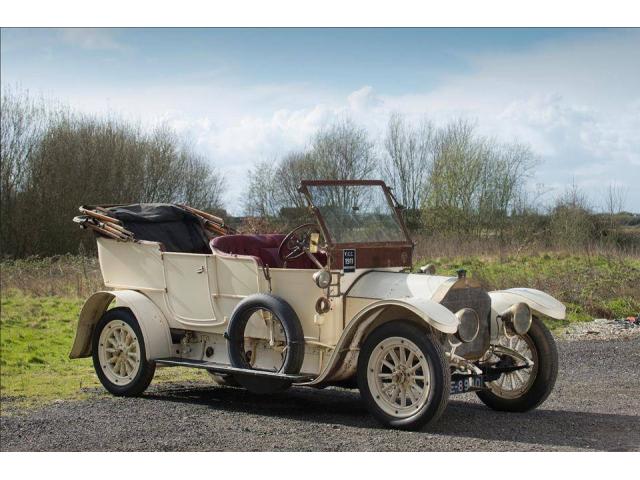1911 Mercedes 28/50 PS
- Brand: Mercedes-Benz
1911 Mercedes 28/50 PS Roi des Belges Tourer Coachwork by Robinson's of Norwich
'(This) 1911 car is a shaft-drive example of what was commonly known in England as the 50hp Mercedes, the German firm's direct answer to the Silver Ghost Rolls-Royce.' – Autocar.
present it here Emil Jellinek to thank for the existence of the 'Mercedes' marque. Jellinek, a wealthy Leipzig-born businessman, was an admirer of the cars of Gottlieb Daimler, and had won the touring car class at the La Turbie hill climb in 1899 at the wheel of one of Daimler's cars. Jellinek began selling Daimlers to wealthy enthusiasts on the French Riviera, and it was the death of Wilhelm Bauer at the wheel of one of these cars that prompted Jellinek to demand something better. Bauer had crashed while competing in the 1900 La Turbie hill climb, and Jellinek believed that the Daimler's top-heavy design had been a major contributing factor. He demanded something with a lower centre of gravity, and commissioned the pioneering manufacturer to construct a new car that had to be light, fast, and beautiful, backing his proposal by paying up front for 36 cars at a total cost of 550,000 gold marks. 'I don't want a car for today or tomorrow,' he is quoted as saying, 'it will be the car of the day after tomorrow.'
Designed by Daimler's collaborator, Wilhelm Maybach, this 5.9-litre, 35hp model marked the watershed between the era of the 'horseless carriage' and that of the modern motor car. Advanced features included a pressed-steel chassis, aluminium cylinder block, 'honeycomb' radiator, atomising carburettor, and gate-change gearbox.
Starkly finished in purest white, Maybach's creation debuted at the Nice Speed Week on 25th March 1901. The car was owned by Baron Henri de Rothschild and driven by Wilhelm Werner, but had been entered by Jellinek under the pseudonym 'Mercedes', his daughter's name. (At this time Panhard-Levassor owner the sales rights to Daimler cars in France, hence the need for subterfuge!). Werner drove the car to victory in the Nice-Salon-Nice race at an average speed of 32mph and two days later achieved a maximum speed of 53.5mph along the Promenade des Anglais, unparalleled performances that emphatically outclassed the opposition. 'We have entered the Mercedes era,' declared Paul Meyan, General Secretary of the Automobile Club de France, an astute observation that was confirmed by the number of manufacturers on both sides of the Atlantic that copied the design. Indeed, so successful was the Mercedes, that Daimler adopted the name for its passenger cars in 1902.
An entire range of cars of varying capacities and power outputs followed - most notably the Mercedes Simplex - all inspired by that revolutionary original. Nevertheless, Mercedes continued to hedge its technological bets, offering models with sidevalve, overhead-valve, IOE, and sleeve-valve engines, and with either shaft or chain final drive.
Within a few years, Mercedes had asserted itself as the foremost make of car in Europe, with various royal households among its customers. The latter even included King George V, who forsook his British-built Daimler when on engagements abroad, preferring the Mercedes. Then as now, the USA was Mercedes' most important export market, and the list of plutocrat owners 'across the pond' included the likes of William K Vanderbilt and Isaac Guggenheim.
Following the departure of Wilhelm Maybach from Mercedes in 1907, the company, along with several others, withdrew from active participation in motor sport, but by 1908/9 was producing an excellent range of shaft-driven touring cars. These were the work of Paul Daimler, Maybach's successor, who had returned to the company from Austro-Daimler. Privateers still campaigned Mercedes products in sport, and in the fashionable endurance events of the time achieved major successes. Not the least of these was the magnificent 1-2-3 victory of three Mercedes 16/50hp cars in the gruelling 2,000 mile Tsar Nicholas St Petersburg-Moscow-St Petersburg Trial of 1910.
Dating from 1911, shortly after Mercedes first adopted its famous three-pointed star emblem, this 28/50hp model was delivered in chassis form to Carrosserie Million-Guiet in Levallois-Perret, France, as confirmed by the Mercedes-Benz archives. Founded in 1854 as carriage makers, Million-Guiet bodied its first automobile around 1900 and was notable for adhering to traditional methods and materials at first, only embracing more advanced techniques after WWI.
This Mercedes 28/50hp is powered by a 7.2-litre four-cylinder sidevalve engine of fixed 'T'-head configuration, the cylinders being cast in pairs. There is twin-plug ignition, one plug being sited above each inlet valve, the other above the exhaust. This system was originally sparked by a single Bosch magneto but is now supplied with sparks by a Simms magneto (exhaust valve plugs) and a high-tension coil (inlet valve plugs). Lubrication is managed by a Friedmann lubricator, with external oil pipes to all engine bearings and various points on the chassis.
Power is transmitted via a scroll clutch to the four-speed gearbox and thence by shaft to the rear axle, there being a separate crown-wheel-and-pinion for each driveshaft. The rear wheel brakes are operated by a hand lever, and there is also a large and powerful transmission brake operated by the brake pedal.
Descriptions & pictures by bonhams
| Specification | |
| Production Start | 1911 |
| Country of origin | Germany |

























